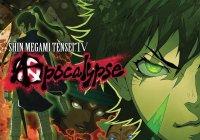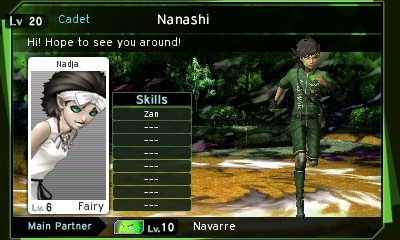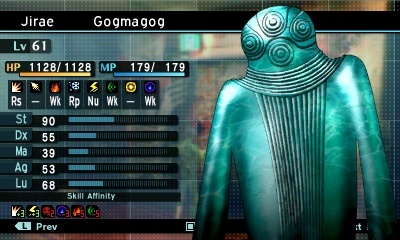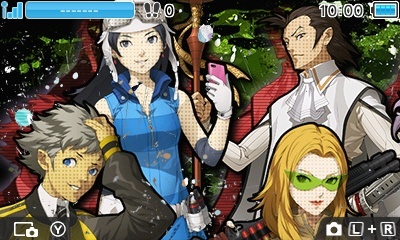Shin Megami Tensei IV: Apocalypse (Nintendo 3DS) Second Opinion Review
By Rudy Lavaux  26.12.2016
26.12.2016

The tail end of 2016 has been great for RPGs on Nintendo 3DS. Who would have thought that after the slow start of the system five years ago that it would go on to become home to so many great titles, especially in the RPG department. Dragon Quest VII came out in September, the smash hit titles Pokémon Sun and Pokémon Moon came out in November and both 7th Dragon III: Code VFD and Shin Megami Tensei IV: Apocalypse came out in early December, offering RPG fans hundreds, if not thousands, of hours of gameplay to enjoy. Atlus' flagship franchise returns to 3DS after the system was graced with its latest numbered entry back in late 2014. Shin Megami Tensei IV was well received by Cubed3 when it hit the European 3DS eShop back then, with the main reproach being how hard it was to get into. Sadly, although not unsurprisingly, this new spin-off title hasn't made it to retail in Europe, either (read the US review here), once more being an eShop exclusive. However, it is now time to see how things have evolved since IV. Have previous complaints been addressed?
The Shin Megami Tensei franchise is indeed not the easiest to get into when looking at most of its main releases. The series has been known to feature first-person dungeons populated by demons and repetitive scenery all the way up to the PS2's third entry. However, the Nintendo 3DS episode did away with those in favour of true to life locations of Tokyo seen in third-person. Those were incredibly detailed, too, especially for the system, all rendered in full stereoscopic 3D. This shift does indeed work in favour of making the series less intimidating, particularly for Western audiences. The spin-off at hand, Apocalypse, is no different, using all the exact same protocols used by its predecessor, with the exception that the action this time starts off in Tokyo itself and not in a land above the ceiling that covers up the capital entirely made of still screens where its inhabitants can only travel through the use of menus.
Indeed, this time the player is sent straight into the main action instead of being distracted by a completely menu driven interface and unique dungeon for a long period of time, which works wonders, making the game all the more attractive. The beautifully rendered real locations of Tokyo in a post-apocalyptic environment were indeed where all the visual impact of the previous game lay. This was, however, held back by hours and hours of trudging through cave-like dungeons and travelling back and forth between that and the menu driven town above. Not this time around, however, as the game opens with Nanashi (literally "Nameless" in Japanese), a teenager who is a cadet of the hunter association of Tokyo, who accompanies two other veterans in the streets of Tokyo on missions to scavenge for relics in the wreckage of buildings and vehicles, as well as demon meat for food. The player is drawn in and hooked to this virtual universe much earlier on, which is one of the best improvements that could be hoped for in this over its older cousin, and kudos definitely goes to Atlus for that.
The story takes place more or less at the same time as the previous game or, more specifically, it plays in parallel to the events that occur should gamers take the neutral path and lock the story to it in Shin Megami Tensei IV as Flynn and Isabeau try to defend the humans still inhabiting Tokyo from the armies of God coming from the ceiling and Satan's, coming from underground, waging war against one another's, not caring for humans caught in-between.

Familiar faces who were not seen again after certain events in SMTIV are now seen again, shedding more light on them and expanding upon the story, although it is not necessary to have played the previous adventure in order to fully appreciate the plot as, conveniently, a database of events, places, and characters provide all the details of what happened before. This is not compulsory whatsoever to understand what's going on, but it's just there to offer people who did not buy SMTIV more insight into its events.
However, on the flip side, this taking place in the same city, at around the same time, means that a lot of locations remain almost exactly the same. Some new ones come into play, while some are not accessible anymore, but, for the most part, Tokyo hasn't changed much. This won't be a problem at all for someone who has not played the other game, yet for those who played it tirelessly to completion, while the elements of familiarity will please, it will also undoubtedly disappoint a little. After seeing the Ueno station and Ameyoko market area once, and taken in how realistic the places look when compared to the real deal, seeing them for the second time, in almost identical form, does not give the same effect all over again. The same can be said for 2D NPC sprites and demon designs, which, save for the few new ones, are simply carried over and recycled. All of this amounts to newcomers being in for an even better experience than the previous episode due to how better it's introduced (and explained), while veterans will mostly be in for the additions, improvements, extra plot, and characters, which thankfully there are quite a lot of within.
The whole basic concept of the Shin Megami Tensei series is that players, using their "in-game" smartphone in recent titles or portable computer-like device in the '80s and '90s games, can recruit demons, store them digitally in their device, and summon them for battle later. This was very Pokémon-like a very long time before Pokémon even came to existence, so while the similarity will likely be felt, just remember that, in Japan, Megami Tensei is at least a decade older. Those demons are, therefore, both party members, in a party of up to four including the human hero, and foes. Bosses obviously can't be recruited, but there are ways to obtain them through special demon fusions that usually unlock after covering certain in-game events, or as DLC. The story is, thus, played out as a fairly classic turn-based RPG with the most defining aspect being the demon recruitment, training, and fusions of two, or more in special cases, in order to create a completely different one.

Recruiting a demon is both as easy and as complicated as simply scouting them in battle. Indeed, since they are demons after all, they are also incredibly malicious. They will randomly only join after softening them through some bartering or verbal negotiation but they may also often-times simply walk away with those presents in a "Bye sucker!" kind of way, which can be very infuriating. They may even stop the battle themselves and plead for their life by offering their services directly, or simply state that they had been waiting to be recruited when a conversation is engaged with them. New to this spin-off is that sometimes, when trying to recruit a demon of higher level than the player's, whom, therefore, would not normally agree to join, they will occasionally call up some other demon of lower level who they had heard was looking for a master, which is a nice little addition, but this is still a rare thing... unless that was already present in the previous game but simply never happened to your servitor here, due to it being so rare.
The battle system in Shin Megami Tensei IV was also a very enjoyable feature, with its press-turn system where a critical hit or a hit with a skill targeting an elemental weakness could result in extra action turns whereas missing a target or hitting an elemental resistance led to loss of action turns, inducing a delightful strategic element that made battles all the more interesting. The same system is in use in Shin Megami Tensei IV: Apocalypse with a few extra tweaks thrown in, such as a "smirk" temporary status earned through press-turns, which greatly increases evasion and critical hit rate until another action is taken by that unit, now carrying over to the next battle if unused at the end of the previous one. This is even more of a great addition considering the Smirk status now has additional effects on skills used, such as being required for instant-death spells to have any effects, or for certain skills like debuffs to have any effect on certain bosses.
Moreover, where in the past demons only had weaknesses and resistances to elements, they now have matching proficiencies with magic. What this means is that a Jack Frost, Atlus's mascot and an obviously ice-elemental demon, will be more effective at using ice-type skills than fire ones, for example, which completely makes sense. This is represented by a number next to their skill similar to a skill level in the hero's move-list.

Demons that are bad at certain elements can, conversely, have a negative number associated to the associated skills, though. Like before, demons can teach the hero their own skills through demon-whisper after learning all that they could learn, and demon-whispering multiple times the same skills raises the level of that skill in his move-list. Demons can also still pass their skills down to a demon resulting from their fusion with another one.
All in all, the systems have been vastly improved, in a way that makes the experience smoother, although not dramatically different. That's not to say, however, that there are no completely new additions. A fine example of this is how vast Tokyo is and how hard it was before, to remember where all the locations are. This was an issue in the previous game, especially to Westerners who have never been to Tokyo and, therefore, don't know where everything is. The mapper app of the smartphone, displayed on the lower screen, now conveniently has a goal icon that shows where the next stop is for the currently active quest or side-quest, which is very helpful. An even bigger addition is that assist characters are now directly selectable. Where before a samurai of the Mikado kingdom could sometimes randomly act at the end of a turn in battle, the hero is now accompanied by Asahi and several other companions who can be manually selected to act in battle and level up accordingly when experience is earned, although conveniently even inactive characters that have joined can also gain experience. Asahi, Nanashi's best friend, is a healing support, for example, healing a character each turn when absolutely necessary, and so on. Additionally, an assist gauge is present that is filled whenever an assist character's action connects with its target, which when it is full, unleashes some other special techniques, which is yet another great addition that adds more depth.
It is, overall, a more enjoyable experience than its predecessor, easier to get into and does well in hooking gamers. It is still a very long experience that requires multiple play-throughs to fully complete. Indeed, getting a complete demon compendium is no easy task. Unlike Pokémon, there are no trading features, or any multiplayer elements whatsoever, for that matter, but it is still a thoroughly enjoyable solo experience. Its only downfall is with veterans of the previous game to whom it will all feel a bit too familiar, for obvious aforementioned reasons. The fact remains, though, that it is globally a better game, and better put together, despite recycling a lot of things in the visual stakes, yet also audio department since certain music tracks from before are also present and completely untouched. Newcomers need not worry about those, and can, thus, go in with eyes closed and simply enjoy the ride, while the others simply need to take this fact into consideration and keep their expectations in check, accordingly. For those, some bonus items can be unlocked if this new game is provided with an SD card containing a save file from the previous release, which is always an appreciated inclusion.

Cubed3 Rating
Exceptional - Gold Award

While a case can be made that it does recycle a lot from its predecessor, taken on its own merits, Shin Megami Tensei IV: Apocalypse comes out on top when compared to the vanilla edition. Better paced, more accessible, with most, if not all, of the things slightly off about its predecessor now ironed out, it proves to be one of the best RPG experiences to be had on Nintendo 3DS, and comes highly recommended. Moreover, it is not a New 3DS enhanced title and plays wonderfully with the stereoscopic 3D turned on, even on older units, which is a rare sight these days on the system, and using the same engine as its older brother, it looks stunningly impressive and still sounds great to boot (headphones highly recommended!). Fans of the previous adventure should like it just as much with their expectations well tuned, while newcomers could not choose a better time to get into the franchise.

![]() 9/10
9/10
![]() 0
(0 Votes)
0
(0 Votes)
 Out now
Out now  Out now
Out now  Out now
Out now  Out now
Out now Comments
Comments are currently disabled

 Sign In
Sign In Game Details
Game Details Subscribe to this topic
Subscribe to this topic Features
Features





 Top
Top

